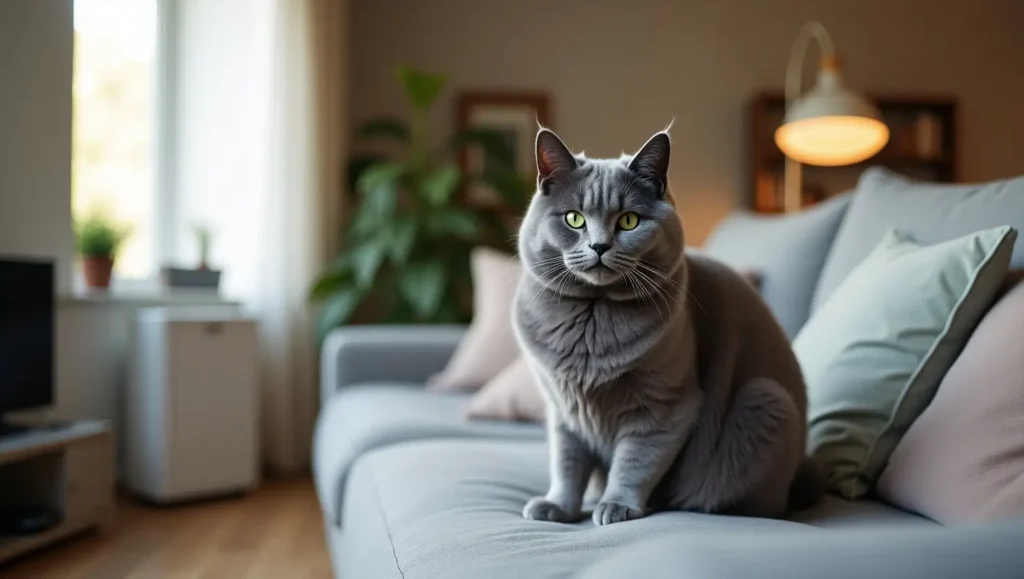Curious if the Russian Blue cat is truly hypoallergenic or just another clever marketing myth? You’re not alone. At WhizPet, we’ve conducted in-depth research tailored specifically for U.S.-based cat lovers who want the real facts behind this popular breed. After analyzing recent studies, expert interviews, and firsthand experiences from allergy-prone owners, we’re ready to bust myths and confirm facts.
In this blog, we’ll explore the question: Can Russian Blue cat hypoallergenic claims fool you? We’ll also share 5 surprising facts to help you decide if this elegant feline is the right fit for your allergy-sensitive home. Whether you’ve seen listings like “Russian Blue cat hypoallergenic for sale” or just wondered why this breed is so highly rated among allergy sufferers, you’re in the right place.
Stick around—because by the end of this guide, you’ll know exactly how much truth there is to the Russian Blue cat hypoallergenic reputation, and whether it’s backed by real science or just wishful thinking.
What Does Hypoallergenic Mean in Cats?
Let’s start by clarifying a common misconception. Hypoallergenic doesn’t mean allergy-free. It means the animal is less likely to trigger allergic reactions. In cats, allergies are most often caused by a protein called Fel d 1, which is found in their saliva, skin, and dander.
When a cat grooms itself, Fel d 1 gets transferred to its fur and skin, then released into the air as dander. That’s what causes sneezing, itchy eyes, and breathing problems in sensitive individuals.
Key Takeaway: No cat is 100% hypoallergenic—but some breeds, like the Russian Blue, may produce fewer allergens.

Why Is the Russian Blue Cat Considered Hypoallergenic?
5 Facts About Russian Blue Cat Hypoallergenic Claims
Let’s break down the hype and science behind this breed’s allergy-friendly reputation:
Fact 1: Russian Blue Cats Produce Less Fel d 1 Protein
The primary reason many believe in the Russian Blue cat hypoallergenic myth is due to their naturally lower levels of Fel d 1, the protein responsible for triggering allergic reactions. While not completely free of allergens, their levels are significantly below average.
Fact 2: Their Double Coat Traps Dander
Unlike most breeds, Russian Blues have a dense double coat that acts as a trap for dander and loose fur. This minimizes the allergens released into your home, making them easier to manage for allergy-prone individuals.
Fact 3: They Groom Themselves Cleanly and Regularly
Russian Blues are meticulous self-groomers. Their frequent cleaning removes loose allergens and maintains a sleek, clean coat — another reason Russian Blue cat hypoallergenic claims persist.
Fact 4: Less Skin Oil Means Fewer Airborne Allergens
This breed produces less sebaceous (skin) oil, which typically binds allergens and spreads them into the air. Less oil means cleaner fur and fewer allergy triggers floating around.
Fact 5: Real Owners Report Fewer Allergy Flare-Ups
Many pet owners with cat allergies report fewer reactions with Russian Blues. While this is anecdotal, it supports the idea that Russian Blue cat hypoallergenic status isn’t just marketing — it’s often backed by lived experience.
Who Should Consider a Russian Blue Cat?
If you’re mildly allergic to cats but still want a feline friend, the Russian Blue may be one of the best breeds for you. However, you should:
- Consult with an allergist before adopting.
- Spend time with a Russian Blue to test your individual reaction.
- Consider home environment changes (e.g., HEPA filters, vacuuming, limited bedroom access).
Do Russian Blue Mix Cats Have the Same Benefits?
Not necessarily. If a Russian Blue is mixed with a breed that produces high amounts of Fel d 1 (like Siamese or Maine Coon), those hypoallergenic traits may be diminished.
If allergy management is your priority, opt for purebred Russian Blue cats from verified breeders.
Are Russian Blue Cats Allergy-Free?
No cat is truly allergy-free. Even among Russian Blues, allergen production can vary from one cat to another. Factors like age, diet, grooming frequency, and environment also play a role.
Fun Fact: Neutered males tend to produce less Fel d 1 than non-neutered males.
Additional Considerations Before Getting a Russian Blue
Russian Blue Cat Personality
These cats are intelligent, affectionate, and loyal—but also a bit shy. They bond deeply with their families but aren’t fond of strangers. This reserved nature makes them well-suited for calm, indoor environments.
Russian Blue Cat Price
Because of their increasing popularity as a hypoallergenic option, the Russian Blue cat price in the U.S. ranging from $800 to $2,500, depending on…:
- Breeder reputation
- Pedigree
- Health guarantees
Russian Blue Cat for Sale: Where to Look
You can find Russian Blue cats:
- Through certified breeders (always verify claims of hypoallergenicity)
- At breed-specific rescue organizations
- Occasionally in shelters or adoption networks
Be cautious with listings like “Russian Blue cat hypoallergenic for sale” — not all sellers are reputable. Ask for health records, allergen testing data (if available), and visit in person if possible.
Comparing to Other Hypoallergenic Cat Breeds
How does the Russian Blue stack up against others?
| Breed | Allergen Level | Personality | Coat Type |
| Russian Blue | Low | Reserved, affectionate | Short, double |
| Siberian | Low-moderate | Friendly, playful | Long, dense |
| Balinese | Low | Social, vocal | Medium, silky |
| Bengal | Low-moderate | Energetic, curious | Short, spotted |
While breeds like the Siberian and Balinese are also marketed as hypoallergenic, the Russian Blue is unique due to its grooming habits and dander-trapping coat.

Real-Life Testimonials: Living with a Russian Blue
Case Study 1: A Seattle-based cat owner with mild asthma “After months of research, I adopted a Russian Blue kitten. I use air purifiers and keep her off the bed, and I’ve had no major allergy flare-ups. It’s manageable, and she’s such a sweet, quiet companion.”
Case Study 2: A New York family with an allergic child “We tested several breeds, but only the Russian Blue didn’t trigger a reaction in our son. We still vacuum often and limit her to certain areas, but we finally have a pet our whole family can enjoy.”
Managing Cat Allergies at Home
Even if you adopt a Russian Blue, here are extra steps to reduce allergens:
- Use HEPA air purifiers in common areas.
- Vacuum frequently using HEPA-filter vacuums.
- Wash hands and clothes after handling your cat.
- Keep the cat out of bedrooms.
- Bathe and groom your cat regularly.
5 Most Frequently Asked Questions
1. Can you be allergic to Russian Blue cats?
Yes. They produce fewer allergens, but no cat is 100% allergy-safe.
2. Are Russian Blue mix cats hypoallergenic?
Mix breeds may not retain the low-allergen traits.
3. Do Russian Blue cats have allergies?
Yes. They can suffer from food or environmental allergies.
4. What is the Russian Blue cat price?
Anywhere from $800 to $2,500 in the U.S.
5. Is there a long-haired Russian Blue that’s hypoallergenic?
Long-haired variants are uncommon and not officially recognized. More hair may actually hold more allergens.
Final Verdict: Can Russian Blue Cat Hypoallergenic Myths Fool You?
The idea that Russian Blue cats are 100% hypoallergenic is a myth—but it’s based on some truth. They produce fewer allergens than most breeds, and their grooming habits and coat structure further limit exposure. If you’re mildly allergic, a Russian Blue may be a great option with the right environment and hygiene practices.
However, individual results vary. Test your reaction in advance, and don’t believe every claim you see online.
Call to Action
Ready to bring home a calm, elegant companion that may actually let you breathe easier? Start by visiting a local breeder or rescue specializing in hypoallergenic cats. Don’t forget to subscribe for more expert insights on cat breeds, allergy management, and pet care you can trust.
Still have questions? Leave a comment below or contact us directly—we’re here to help you find the purr-fect match!
Related blog: For more detailed information about pet care

